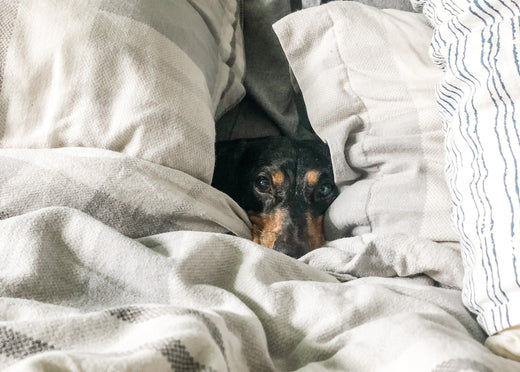If the winter season is coming up, learning how to keep your dogs warm is a must!
Many assume that because dogs have fur, they are automatically immune to cold temperatures, which is far from the truth. Not all dogs have the same fur coat - which means not all dogs are capable of withstand the same harsh conditions outdoors. Some dogs have short coats, while others have thick, fluffy coats. Dogs with thick fur coats, like the Siberian Husky, are more suitable to withstand cold temperatures. However, they are still susceptible to risks like hypothermia and frostbite once the temperature drops past a specific marker.
That’s why today, we’re going to teach you how to keep your outside dogs warm in the winter. You’ll learn the risks of leaving your furry friends outdoors during frigid weather, along with tips and tricks to make them more comfortable - more importantly, keep them safe. Continue reading for the best information on how to keep your dogs warm in the winter!
First Things First - Does Your Dog Need to be Kept Warm in the Winter?
If you have a husky and live in Arizona, you don’t need to do much to keep your dog warm during the winter. But if you live in a state like Montana or New York, your dog may be at risk if not correctly taken care of to combat the cold weather. That’s why we highly recommend learning how to keep outdoor dogs warm in winter!
Your dog may be at risk of hypothermia and frostbite if not adequately equipped to keep warm or if your dog is left out in certain temperatures that could result in the previously stated risks. Protecting your dog by learning what temperatures can be dangerous or safe for your dog to be subject to for prolonged periods of time can benefit your dog from serious harm. Continue reading to learn how to keep your dogs warm in the winter!
Certain Dog Breeds Stay Warmer Than Others
Not all dogs are equipped to handle cold weather, so knowing how to keep outside dogs warm in the winter is essential depending on the breed you’re a parent to. Certain dog breeds have been bred to be resilient in cold weather. They can come in different shapes, sizes, and colors. However, they have one characteristic in common---thick fluffy coats!
Thick coats help to preserve heat when temperatures become chilly. These impressive thick coats can manage to provide warmth in temperature when they hit below, too!
Common cold weather dog breeds include Saint Bernard, Siberian Husky, and German Shepherd. And though these breeds may be more acclimated to the cold weather, that does not mean they are invincible to it. Issues like hypothermia and frostbite can still occur with these breeds as each dog has its limit with cold weather. Sometimes even cold weather dogs need to be equipped with snow boots or outerwear to protect them from overexposure. That’s why learning how to keep outside dogs warm in the winter is essential to prevent harm to your doggo!
It’s also worth noting that age plays a factor in whether or not your specific pup can “weather” the storm (pun intended). If your dog is a bit older, the cold will take a toll on their joints. You’ll find that they don’t move as well during winter months - and if they’re left outside, this issue will be exacerbated.
Your Specific Climate Dictates How Cold Your Dog Really Is
For most dogs, anywhere from 45 F and up should be no problem. However, this can depend on your dog's size, age, and coat. Anything below 45 F and things can get tricky, as each dog has a different comfort level. More cold weather-equipped dogs like Bernese Mountain Dogs will be able to adapt to the lower temperatures, but breeds such as the Pitbull may need some cushion to maximize comfort during longer trips outside.
Why Learning How to Keep Dogs Warm in Winter Is So Important
Each dog and dog breed has a different tolerance to temperatures, some more suitable for acclimating to extreme cold than others. However, keeping dogs warm in winter is essential to preventing significant issues such as hypothermia and frostbite.
There is a significant risk for dogs not designed for low temperatures below 45 F and even some cold weather dogs below a specific temperature. Important issues such as hypothermia can result from your dog’s temperature falling below average from overexposure to cold temperatures or wet fur in a cold or windy environment. Frostbite can also occur if temperatures drop below 32 F if your dog is not protected against winter’s cold.
Keeping your dog warm and protected is essential to preventing these painful health concerns that can afflict your dog!
How to Keep Your Dogs Warm in the Winter: 4 Ways to Protect Your Pup
The Winter season is no joke with its frigid temperatures, cold rain, and wind that blows right through you. If you feel the cold, your dog does too! That’s why we recommend checking out these top methods on how to keep dogs warm in winter.
Just Bring Them Inside!
If you have a dog breed that is not accustomed to cold weather or does not have any protection to be outside for prolonged periods of time, bring your dog inside. Puppies or short-haired dogs should be brought inside if temperatures drop below 40 F. Any other outdoor pets or cold-weather dogs should be brought in if temperatures drop below 20 F.
Doing so will protect your dog from hypothermia and frostbite by being exposed to cold temperatures for an extended period of time.
Give Them a Soft, Cozy, Warm Bed & Blanket
At Lucky Paws our calming beds for dogs don’t just help ease anxiety - they’re ultra soft and warm, helping you keep your pup cozy. Better yet, add one of our thick, insulated dog anxiety blankets. This tandem will keep your four-legged friend happy and healthy even in cold conditions.
The extra stuffing in our calming beds allows for maximum comfort for your dog. In addition, the super soft faux fur is hypo-allergenic and dust resistant made with high-quality materials that function as a soothing dog bed for man’s best friend. In fact, it keeps your doggo warm and soothes anxiety for your dog!
Plus, our waterproof calming blankets stave off anxiety attacks that may aggravate your dog. It soothes your dog while providing the necessary warmth to keep them nice and cozy during the cold winter months. As a bonus, our calming blankets will protect your home from scratch damage, dog hairs, spills, and more preventative issues that may come from owning a dog.
Now, it’s worth noting that you shouldn’t leave your dog outside in below freezing temperatures if their breed isn’t accustomed to these conditions - even with a Lucky Paws dog bed and blanket combination. However, our products are sure to help your pup stay warm and cozy even in uncomfortable conditions.
Dress Them Up A Bit
Another method to keep your dog warm during the winter is investing in a jacket or sweater. Unfortunately, breeds like French Bulldogs and Chihuahuas have short coats that don’t provide much, if any, warmth under 40 F.
If you intend on taking your dog on walks outside during the chilly winter months, we recommend investing in a doggie sweater or jacket that will insulate heat to keep your pupper warm. We suggest a doggie sweater or jacket that is snug but not constricting, allowing for freedom of movement for your dog. These are great methods for learning how to keep outdoor dogs warm in winter!
Do What You can to Warm up Their Space
If they’re staying in the garage, add a space heater. Garages can get incredibly cold, especially with the cold flooring and lack of heat. A space heater will efficiently provide warmth for your dog to prevent hypothermia in a space that is lacking in warmth.
If they’re in a dog house outside, insulate it. This is an excellent method how to keep outside dogs warm in winter. Doing this will block out the cold and aid your dog in retaining its body heat. The dog house should not only be insulated but packed with dry and clean bedding material to prevent frostbite or hypothermia, which can progress when in contact with wet materials.
If they’re indoors, turn on the heater or start a fire. The heater and the fire will enhance the overall heat in the area, giving your dog the necessary warmth to combat the overpowering chill of the winter months. Be attentive with the fire, so your dog does not accidentally get too close and burn themselves!
Understanding When It’s Too Cold For Your Dog Outside
To learn how to keep dogs warm in winter, you need to know what temperatures to be wary of for the upcoming winter. As not all breeds are created equal, checking out the below information will help signify when it’s time to bring your dog in.
Above 45 F is not a problem for most breeds of dogs, though we recommend keeping an eye on your dog to ensure that they adapt or have the coating thickness to provide insulation and warmth.
Below 20 F, all dog owners are not recommended to leave their dogs outside. During these cold conditions, hypothermia and frostbite can develop, which can be harmful if your dog is exposed for a prolonged time.
There are more tips on how to keep outside dogs warm in winter. Some warning signs to look out for include paled gums, lack of coordination, lethargy, dilated pupils, or if your dog is curled up. These are all signs of hypothermia and can be prevented if looked out for.
Final Thoughts on How to Keep Dogs Warm in Winter Months
The winter months can get chilly, for humans and dogs! So learning how to keep dogs warm in winter is a must. Making sure your dog can handle the often frigid temperatures that come during the winter months is essential to preventing hypothermia and frostbite for your favorite pupper. In this article, we’ve gone over the best ways to keep your dog warm during winter, including investing in Lucky Paws’ calming beds and calming blankets. Both of our products will provide the ultimate comfort and warmth for your dog to combat low temperatures and are proven to ease anxiety and protect your home from damage like scratches or spills.
If you’re looking to keep your dog warm this winter, we highly recommend investing in our products to soothe your dog’s nerves while they bask in warmth and undeniable comfort. So start investing in your pupper today!




Leave a comment
This site is protected by hCaptcha and the hCaptcha Privacy Policy and Terms of Service apply.